-
Posts
401 -
Joined
-
Last visited
Content Type
Profiles
Forums
Gallery
Events
Posts posted by Force9
-
-
Hello Wade
Thank you for the note! I think you'll enjoy your Connie build - it is a terrific kit that makes for an impressive display right out of the box.
I would, however, suggest any modeler to consider implementing at least two modifications: Thicken the bulwarks around the gun ports (you don't have to panel the entire interior - just add styrene around the inside edges) and build your own capstan for the upper (spar) deck. The kit provided version is pretty lousy. You can find my approach earlier in my log - I don't think you'll find it too challenging to replicate.
If you want to get something into the nursery before the child turns eighteen (about the pace I'm taking!) you could also consider an "Admiralty Model" type approach. Build the hull and skip the masts and rigging - or just show the stumps of the lower masts. That'd knock off a year or so of effort and perhaps reduce the intimidation factor. It would have the added benefit of being less fragile.
Please post a log of your progress and don't hesitate to ping me or any of the other Connie modelers with any questions/clarification. Those of us who've gone before can at least help you avoid some of our own pitfalls!
Thanks again for reaching out!
Evan
- james_carder and lambsbk
-
 2
2
-
The Burton pendants had another important function... They were set up first and used in conjunction with the Burton tackle to sway the lower masts in preparation for rigging the shrouds and stays. They would steady the mast and hold the proper position/rake as the shrouds were set up... Afterwards, the pendants were utilized to tighten the shrouds. I think I've seen a few models with the Burton Tackle still rigged to the pendants on deck.
Evan
-
Robert Gardiner in his recent history of frigates using NMM ship models notes that the royal poles became standard on frigates in 1779 (and the flying jib boom in 1794). It is likely that they were commonly utilized prior to becoming standard issue. As noted, the royal yards were usually set "flying"... Rigged from the deck and hoisted into position without buntlines. Sometimes they would be tied to the upper shrouds for storage (I think I've seen that on at least one model - can't recall where...).
EG
-
Here also is my entry regarding the available CD from the Naval History command. Note the links...
I thought I should share another source of research material now available... The fine newly updated version of the USS Constitution CD produced by the Naval History & Heritage Command (NHHC). The CD includes many plans compiled by the Boston Detachment of the NHHC. It mostly includes copies of Lt John Lord's drawings used for the 1927 restoration. As such, they are not necessarily pertinent to the 1812 period, but do have some useful drawings of details like whale boats, Anchors, etc. In particular, there are some historical references also included that I have found very interesting. Finally, the drawings often include notes and links to sub-references that clarify the differences between the 1927 and 1812-14 versions.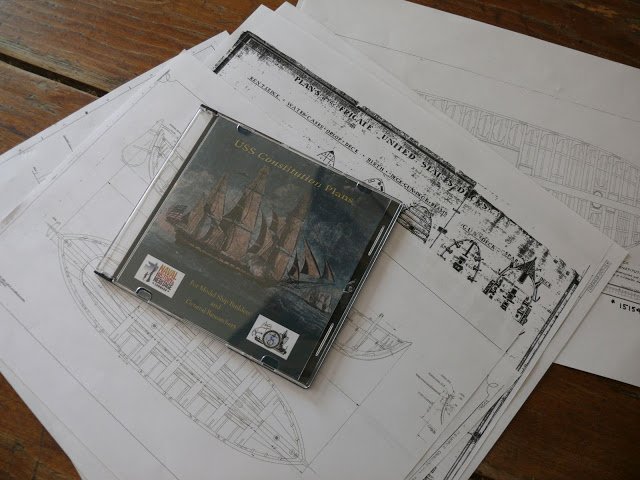
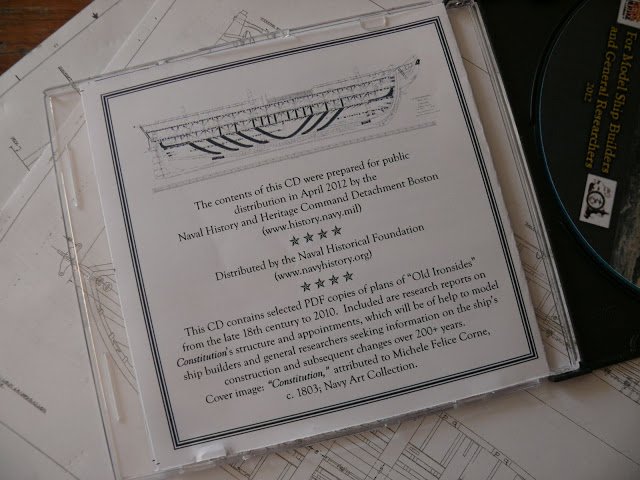
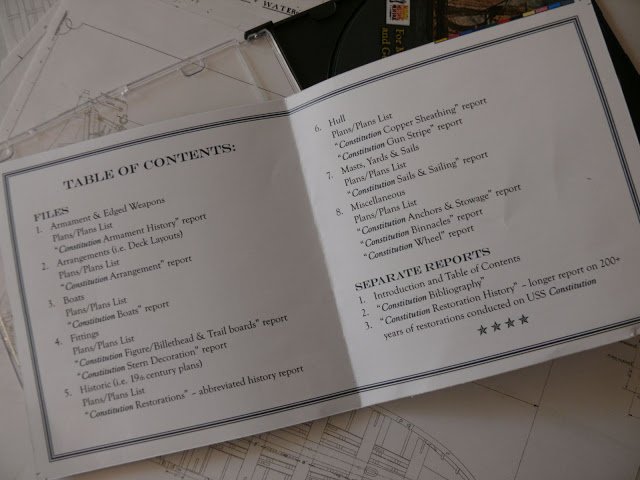 It should also be pointed out that the updated website for the NHHC/USS Constitution includes a very nice virtual tour of the ship:The tour includes links as appropriate to many of the documents/plans included in the new CD. Click on the FILE REFERENCE tab:This link contains good stuff! I highly recommend anyone interested in the great ship to peruse the link and explore the material available...Enjoy!
It should also be pointed out that the updated website for the NHHC/USS Constitution includes a very nice virtual tour of the ship:The tour includes links as appropriate to many of the documents/plans included in the new CD. Click on the FILE REFERENCE tab:This link contains good stuff! I highly recommend anyone interested in the great ship to peruse the link and explore the material available...Enjoy! -
I'm not sure that is strictly true... The stated purpose of this refit is to do a complete/extensive replacement of the under body planking and copper plating. Beyond that I don't think there is any "official" word... Certainly we'd all hope that some provision could be made to bring either the bow or stern into better alignment with her glory years. There may be nothing definitive, but following guidance from the Hull model would be a reasonable approach - at least much better than the current configuration that is widely acknowledged to be very wrong for her 1812 appearance!
They may change the gun port lids to the half "buckler" type that seems to have been researched and corroborated by Ms. Desy (the official historian of the ship).
We can only hope...
Regarding research and good sources... I have discussed some sources for my build in my log... I'll copy my entry here:
It is amazing how little is certain even with a famous ship like Constitution...
Now that I've reached the spar deck, I realize that I will need to cherry pick across the various sources to choose different elements from conflicting information - and from here forward they will be very visible.
With that in mind, I think it'd be appropriate to pause a moment and re-evaluate the sources at my disposal.
My build still relies primarily on the Michele Felice Cornè series of paintings of the Guerriere battle and the "Hull" model - both in the Peabody Essex museum collection. Where possible I will follow these sources with a few bits of artistic license tossed in the mix (I've already deviated somewhat with the stern gallery windows).
The works of Commander Tyrone Martin are a popular resource. I have most in my collection:
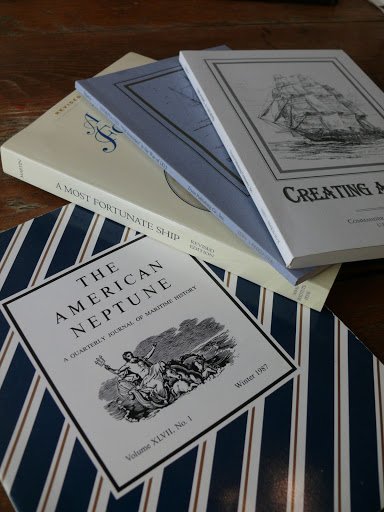
I've already utilized his "Creating a Legend" to add interlocking deck planks on my gun deck. His "A Most Fortunate Ship" is the premier reference for the biography of the ship. Be warned, however, that his take on the Guerriere fight is controversial. Most "modern" historians have generally dismissed his version - including Margherita Desy, the official historian of the ship attached to the NHHC DET Boston.
Here are some great books for model builders:
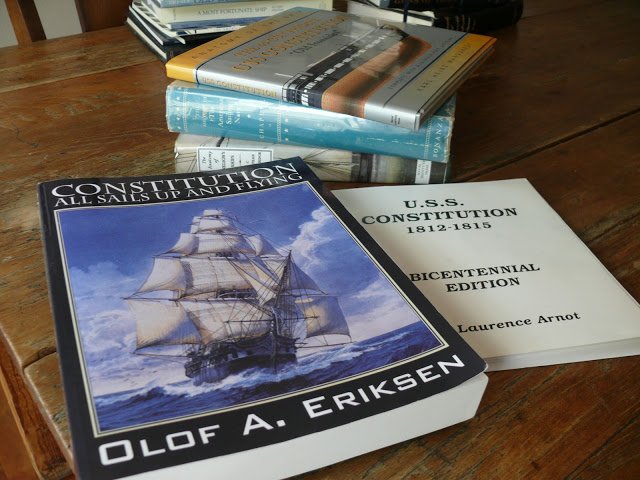
The AOTS USS Constitution by Karl Heinz Marquardt is a common reference. His reconstruction of the ship, however, is questionable... It seems to be a concoction based on some historical influences mixed with the 20th century restoration. Not particularly useful for my attempt to recreate her August 19, 1812 appearance.
Chappelle's History of the American Sailing Navy is a standard reference and includes the very useful drawings of the US Frigate President copied from British records made after her capture. I've used this for the layout of the various pumps on the gun deck.
I've already referenced the Bluejacket kit manual. That is a terrific resource to have if you can only add one of these to your stash. Great overview of both the hull and rig - and it includes full 1/96 scale rigging plans.
The book in the foreground is new and deserves more comment. My forum friend Marcus from Germany finally put me over the edge with his glowing recommendation. It is a very expensive purchase, but well worth it to me. Olof Eriksen built a very large stainless steel model of our ship and he went to extraordinary measures to thoroughly research every aspect - especially the rigging. He initially compared notes with Larry Arnot who then connected him to Commander Martin. Thru Martin's good offices he gained access to the Hull model and conducted a complete survey which even included micro-cameras inserted into the lower deck. Cmdr Martin also provided him with a copy of Midshipman Anderson's journal made when the ship was being restored to her 1812-1815 configuration in the 1830's. Additionally, Mr. Eriksen was able to make copies of the very rare The Naval Apprentice's Kedge Anchor. Young Sailor's assistant. (1st edition 1841) by William Brady. This reference allowed him to not only compare American practices against British, but also allowed him to compare between Brady, Midshipman Anderson's journal, and the Hull model to find consistencies. Practices that Mr. Eriksen matched across all three were likely to be very accurate and were incorporated in his model.
Bill did a good job of summarizing the various decisions and friction points in understanding how the great ship was configured during the war. Ultimately however, there comes a point where some of the available information will be contradictory and the modeler will need to make choices based on personal bias and comfort level.
Good to see other modelers taking on the 1812 version of Connie!
Evan
-
Dirk -
I don't think the docent was wrong - his view was accurately based on how the Constitution's stern has represented the rudder chains for more than a hundred years. Clearly this set up would not allow for emergency steering and would be best suited for withstanding strain and keeping the rudder attached to the chains after an accident. You and I, however, are more concerned with how the rudder chains would've been configured in 1812 or thereabouts - and the "modern" version is likely incorrect for that period.
Your pictures of Boudroit and the La Flore model are extremely interesting. There are two different pendants in use. The "upper" pendant is attached to the rudder chain and secured under the counter. This would seem to suggest a setup for preserving the rudder in case it was wrenched loose. The "lower" pendant secures directly to a bolt on the rudder and appears to be led around the quarter and eventually up to the mizzen channel. This would likely align with an emergency steering purpose. I don't think this is what is described by Steel... This would appear to be more of a "continental" approach. I think Steel describes something more appropriate to the Royal Navy practices?
I will try to replicate something close to the Hull model (and similar to your approach) for my build - with chain substituted for the thin rope led to the rudder. The ends appear to be served, but I'm not certain if the pendant should be "tarred" black as suggested by the model?
Thanks for showing patience with my thoughts!
Evan
-
Hallo Dirk
This topic has been very interesting to me because it reminded me of a conversation I had many years ago (1997?) with a docent on board the USS Constitution. A small group of us were discussing the rudder and I mentioned something about the emergency steering chains. The docent corrected me and insisted that the rudder chains had nothing to do with steering. He pointed out that they were attached to the counter with eyebolts and couldn't possibly be used to control the rudder. He said they were used to preserve the rudder and extended under the entire counter and attached at several points so that the stress could be distributed if they suffered a hard pull and increased the chance that the chains held fast if the rudder was jarred loose. This made sense to me and seems to be reflected in the majority of contemporary (Napoleonic period) ship models. That was the source of my comments - I admit it may not be authoritative.
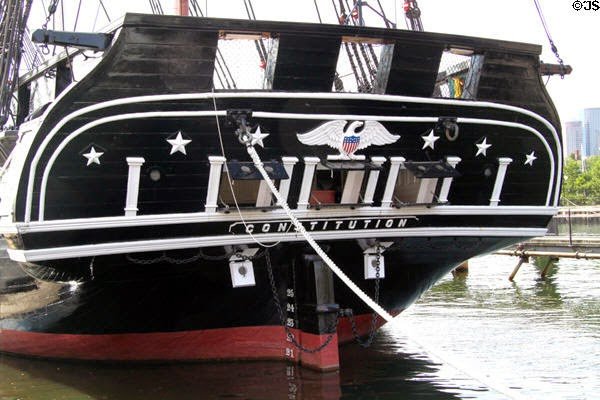
I know you have Harland as a reference. He states: "[Rudder chains] were shackled to a stout metal strap bolted to the rudder-horn, the upper after corner of the afterpiece of the rudder, just above the waterline. The chain was becketted loosely around the counter, to allow the rudder sufficient play, and to the forward ends were spliced rudder-pendants, which were made fast to the mizzen channels. The main purpose of the rudder chains was to secure the rudder, should it be jarred loose from going aground. In addition, by rigging tackles on the pendants, they could, at a pinch, be used to steer."
"Becketted loosely" would seem to correspond with Daniel's representation and the restored Victory in Portsmouth.
To add to the confusion... I've been using my own pictures of the Hull model as references for my Constitution build. As you may already know, this model was built by the crew and presented as a gift to Captain Isaac Hull. The model shows a slightly different arrangement:
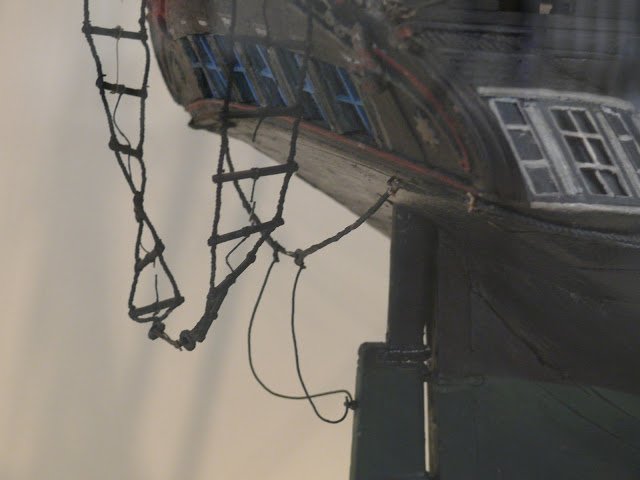
It is likely that the crew didn't have access to any scale chain and had to use rope instead, but I wonder if the heavy served rope under the counter is accurate and the thinner rope leading up from the rudder should be chain. The heavier line is terminated abruptly under the quarter gallery and is not led up to the mizzen channel:
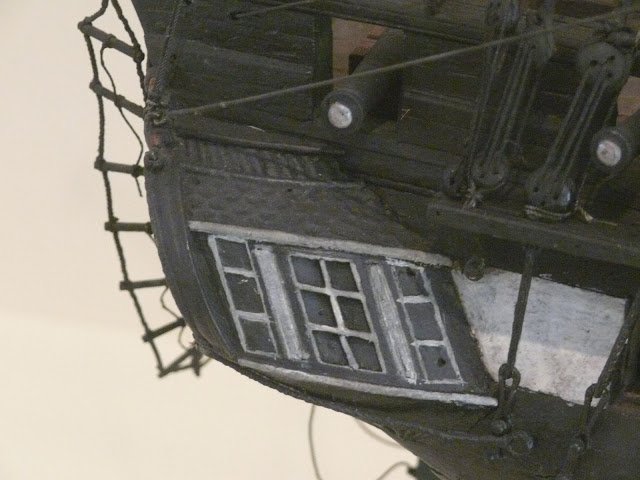
I'm not sure we can settle anything either way, but it seems that modeler's will need to determine which source matches best to their own perspective and go forward with that...
Evan
-
Daniel/Dirk...
I've also read the Steel description as well as some others and I think you've correctly assessed the description... I interpret this as saying that there are RUDDER CHAINS and there are RUDDER PENDANTS that attach to the rudder chains. The rudder chains serve the central purpose of securing the rudder and aiding in preventing the rudder from turning too far - which creates drag and can damage the rudder and/or stall the steering. A longer length of chain is commonly used (but not always) and attached to eye bolts under the counter to distribute the stresses should the chain get yanked with force if the rudder is wrenched loose in a storm or grounding. Additionally, it made sense to attach a rope (pendant) to the rudder chain so that the chains could also be used for emergency steering in the rare case where the rudder head is damaged, but the remainder of the rudder is still intact enough to function.
Many contemporary models show rudder chains fitted, but not rudder pendants. I would think a prudent commander would rig the pendants prior to a battle for emergency use - a stern rake is precisely the situation where the rudder head might be too damaged to support an auxiliary tiller.
In the case of emergency steering, RUDDER TACKLES are the series of blocks and rope that give mechanical advantage and link directly to the tiller head, pendants, or chains (depending on damage and contingency) to allow control in steering the ship with the damaged rudder.
Clear as mud???!!!
Evan
-
Thank you Tim, Christian, Stuart, and Frank for your continued interest... Thanks to everyone who clicked the LIKE button!
Tim - I'm not sure where a kit bash crosses over to becoming a scratch build... I'm almost certain that I've modified every kit component I've used or otherwise replaced it with something scratch built. I really don't think I've yet used anything straight from the box. All part of the fun!
Stuart - I used Plastruct rod 4.0mm and 4.8mm (#s 90862, 90863) for the wheels/trucks. I made a simple jig using scrap styrene to keep a consistent width. I used drill bit sizes 11/64 and 3/16 to drill holes in the styrene that I built up to the appropriate thickness. After snipping off some narrow slices from the rod, I'd insert them into the jig and file them flush to the styrene surface. I made multiple holes in the jig surface so that as the jig was worn down with the filing I could rotate to another hole and maintain the approximate width. I could make a dozen or so before everything was filed down too far and I had to add new holes to the jig.
Haven't had much shop time, but slowly making more wheels.
Thanks for keeping tabs
Evan
-
It is interesting how an official report attempts to put the best spin on what both sides would seem to agree was a bloody repulse. Amazing how these privateers - which generally weren't heavily manned - were able to hold off such assaults... Reid's crew did even better in the famous incident in the Azores near the end of the war.
Great to read thru these accounts.
Evan
- Hank and uss frolick
-
 2
2
-
Thank you all for the LIKES!
Now let's discuss the kit gun barrels...
We know that the 1807 pattern 24 pdrs on Constitution measured 9' 6" and the OOB versions match nicely:
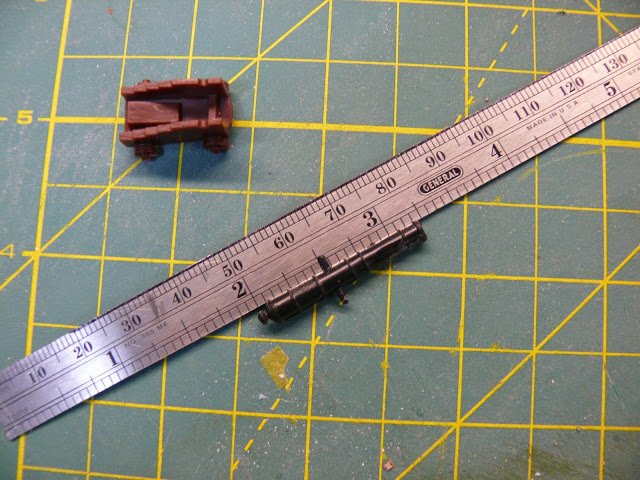
The kit provided barrels are perfectly fine, but they lack a certain menace... They seem a bit thin to me. With that in mind, I had included some of the white metal versions in one of my Bluejacket orders for comparison:
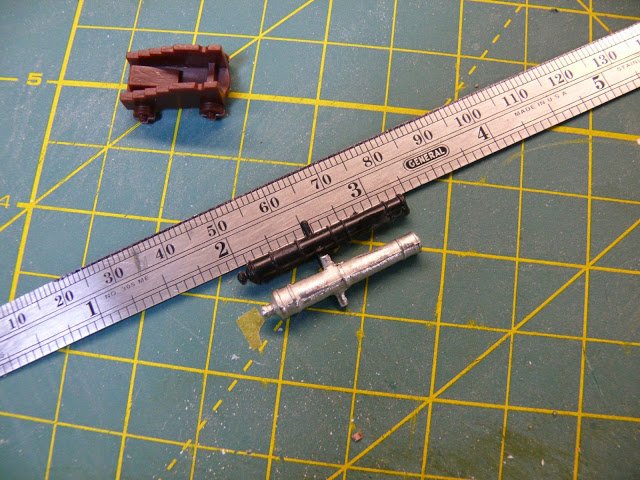
These are a nicer fit, I think... They have more of the requisite girth I'm looking for and they generally show similar proportions to the 1794 pattern preserved in South Carolina:
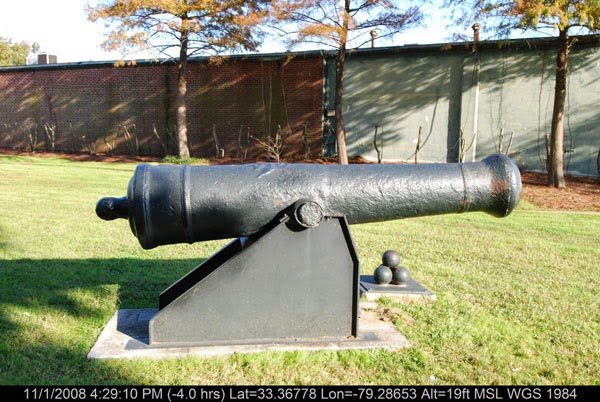
But where have I seen a barrel like that before...? Aha - the Heller Victory:
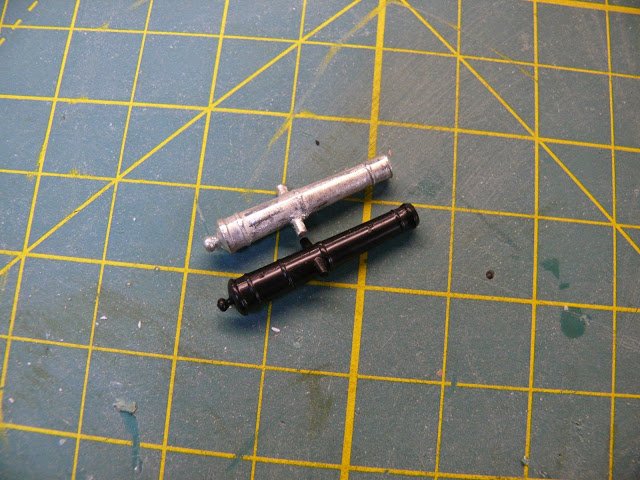
The Heller kit includes a bunch of these barrels to represent both the 32 pdr and the 24 pdrs on the lower decks. I have two Heller Victory kits, so it'd be no big deal to repurpose a set for my Connie build. Heck, I could utilize the Connie 24 pdrs on the Victory down the line...
Now notice how the trunnions are represented on the Heller versions... They sit off center down lower. We see this in the 1794 pattern barrel as well. This positioning allowed for a better depression angle when sitting in the gun carriage, but was inherently weaker than center cast trunnions. The 1807 pattern 24 pdrs apparently utilized the trunnions on the centerline.
Here is how the barrels would need to sit if the barrel is mounted properly:
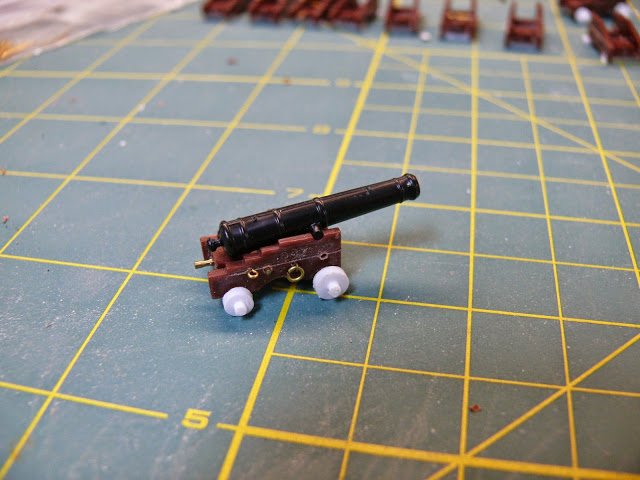
This looks fine, but the upward angle is a little awkward sticking out of the gun port. Mounting the same barrel upside down gives a better angle out of the gun port and sits down nicely in the carriage:
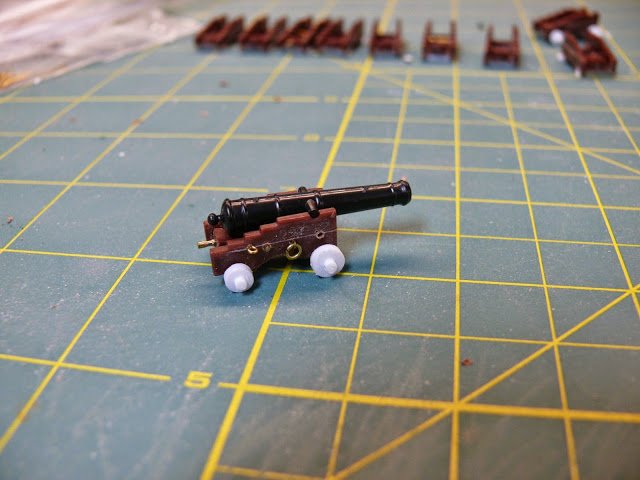
But the gnawing fact remains that it is upside down. The solution is to remove the molded trunnions and add the properly centered trunnions:
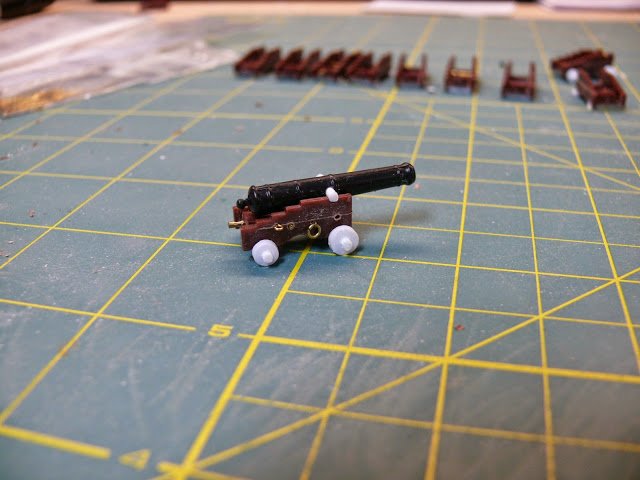
Much better. Looks like I have more holes to drill... Be back in a week or so!
Thx
Evan
- james_carder, foxy, JerryTodd and 5 others
-
 8
8
-
Sorry to nitpick, but Constitution lost her wheel in battle with Java - NOT with Guerriere. If your source stated otherwise, it would not be reliable.
Evan
-
Hello Stuart!
Just catching up on your initial progress - great work!
Regarding the planking - Mine is an exercise in plastic modeling and I never really considered wood for the decks. I was worried about having to smear glue all over the place if I used styrene strips so I first tried scribing the decks. If that had not turned out well, I would've fallen back on the styrene strip decking after first painting each strip in random tones.
Have a look at this build:
http://www.wettringer-modellbauforum.de/forum/index.php?page=Thread&threadID=46887&pageNo=10
Your boats are wonderful. I've only kitted out the small boat so far... I've got the thwarts and all the interior details cut and fitted, but not glued. I need to figure out the sequencing for painting the interiors first.
Have a look at your boat plans again - there should be provision for fitting some masts that you may want to add before you finalize and paint.
You are very ambitious for lengthening the launch - you'll find examples of other modelers (more skilled than me!) doing this same exercise to adapt this boat to the Heller Victory on the Pete Coleman Victory Modellers site:
http://www.pete-coleman.com/forum/index.php
I will enjoy keeping up with your progress!
Welcome to the Connie club!
Evan
-
Thanks Dave, Tim , Daniel, and Chris!
Tim - the "Creating a Legend" book has some sketches of the concept of the interlocking planks, but they just reflect what I tried on my gun deck. Martin says they spanned about 40 feet between each interlocking join, but the restored ship has them much shorter...
Your insight regarding the transfer of crew and guns to the great lakes is very interesting. The timing of the crew transfer may have been the spring of 1813 rather than September 1812. I don't think the General Pike even started construction until April 1813. I think most of the Constitution crew from the Guerriere battle stayed intact and participated in the Java win. Bainbridge apparently sent several contingents of crew to the Lakes after he returned from his cruise and the Constitution began her more extensive 1813 refit.http://usscm.blogspot.com/2013/04/you-know-how-to-beat-those-fellows.html
I've only seen a reference to the General Pike being armed with the "1794 pattern" 24 pounders - the shorter versions similar to what was removed from Constitution in 1808. Tyrone Martin says that the old Constitution guns were generally repurposed for the gunboat fleet favored by Jefferson.
It may be that some of these shorter Constitution versions still exist... Here are some 1794 versions displayed at the entrance to the old armory in Savannah, Georgia: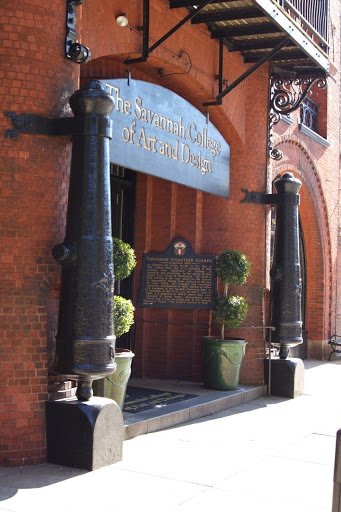
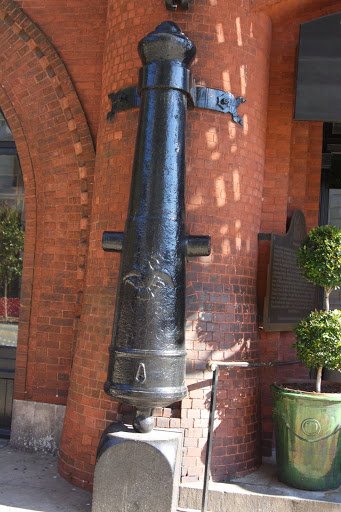
These are numbered 83 and 81 and researchers believe they are part of the original batch of 90 that were delivered to the navy for use in the new frigates. It may be that these were used to bombard Tripoli in Preble's day.
They measure 105 inches in length and are marked as weighing 46-0-0 hundred weight - about 5040 lbs. The Eagle emblem is very cool... We all need to sweet talk Daniel/Dafi into creating scale PE versions for our next builds!
http://markerhunter.wordpress.com/2010/03/06/early-american-navy-24-pdr-guns/
http://www.captainsclerk.info/speaks/book07.html
http://www.napoleon-series.org/military/Warof1812/2006/Issue3/c_ussconstitutionguns.html
Good stuff!
Evan -
Tim - I think the interlocking planking was inherent in the initial design. There was a row alongside the hatches and another about midway between the hatches and the bulwarks.Time for some attention on the guns...There is still some lingering confusion regarding the armament during the War of 1812 - likely caused in some degree by the misrepresentations on the restored ship.The royal cyphers on the gun deck 24 pdrs are an artifact of the 1927 restoration that turns out to have been a bit misguided.
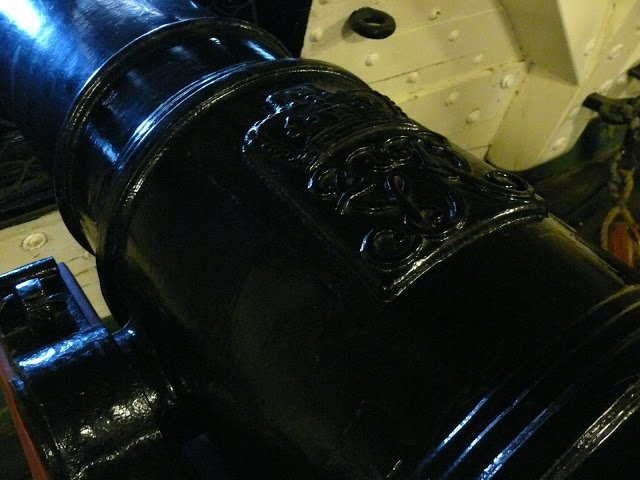 More modern scholarship has firmly established that the armament for Old Ironsides was almost entirely home grown. A notable exception was late in the War of 1812 when Captain Stewart replaced a few of the carronades with English "gunnades" that were liberated from a captured RN supply ship. These would've had the royal cyphers. When Constitution was first launched, she borrowed some guns from Castle William (now Fort Independence) in Massachusetts until the domestic foundry could catch up with demand. These may have been British or French gun tubes - perhaps Revolutionary War surplus. They could've even been some of the guns sledded over from Fort Ticonderoga to drive the British out of Boston. It is unlikely that the British abandoned any intact guns at Castle William when they left Boston, although a few may have been inventoried in local armories. What the British could not take with them would've been spiked or otherwise disabled.We know now that Constitution was armed with thirty 24 pdrs on the gun deck during the entire War of 1812. These versions were 9'6" long and cast in 1808 by the Cecil Ironworks in Maryland. The original 24 pdrs were about 8 feet long and were replaced with this newer set after complaints by one of her commanders that the shorter versions lacked range and accuracy.I have dabbled a bit with modifying the kit provided carriages to include more representative detail... The trucks are too small (and poorly molded) and of course none of the hardware is in place. I added the curvature under the carriage, scribed a line to represent the two pieces of the carriage sides,removed some of the material in the back under the quoin to give it a more "dimension", and added the brass pin and various eyelets, bolts, and rings for the breeching. I also added new axles and wheels:
More modern scholarship has firmly established that the armament for Old Ironsides was almost entirely home grown. A notable exception was late in the War of 1812 when Captain Stewart replaced a few of the carronades with English "gunnades" that were liberated from a captured RN supply ship. These would've had the royal cyphers. When Constitution was first launched, she borrowed some guns from Castle William (now Fort Independence) in Massachusetts until the domestic foundry could catch up with demand. These may have been British or French gun tubes - perhaps Revolutionary War surplus. They could've even been some of the guns sledded over from Fort Ticonderoga to drive the British out of Boston. It is unlikely that the British abandoned any intact guns at Castle William when they left Boston, although a few may have been inventoried in local armories. What the British could not take with them would've been spiked or otherwise disabled.We know now that Constitution was armed with thirty 24 pdrs on the gun deck during the entire War of 1812. These versions were 9'6" long and cast in 1808 by the Cecil Ironworks in Maryland. The original 24 pdrs were about 8 feet long and were replaced with this newer set after complaints by one of her commanders that the shorter versions lacked range and accuracy.I have dabbled a bit with modifying the kit provided carriages to include more representative detail... The trucks are too small (and poorly molded) and of course none of the hardware is in place. I added the curvature under the carriage, scribed a line to represent the two pieces of the carriage sides,removed some of the material in the back under the quoin to give it a more "dimension", and added the brass pin and various eyelets, bolts, and rings for the breeching. I also added new axles and wheels: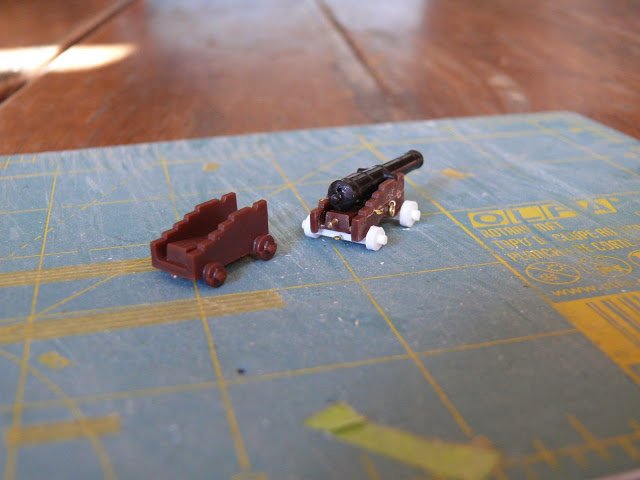
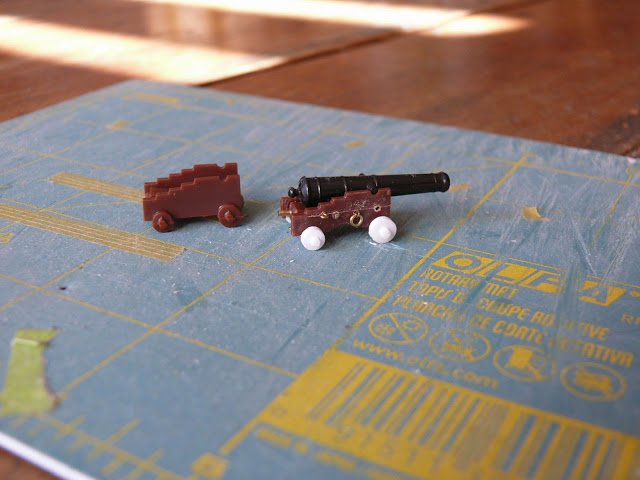
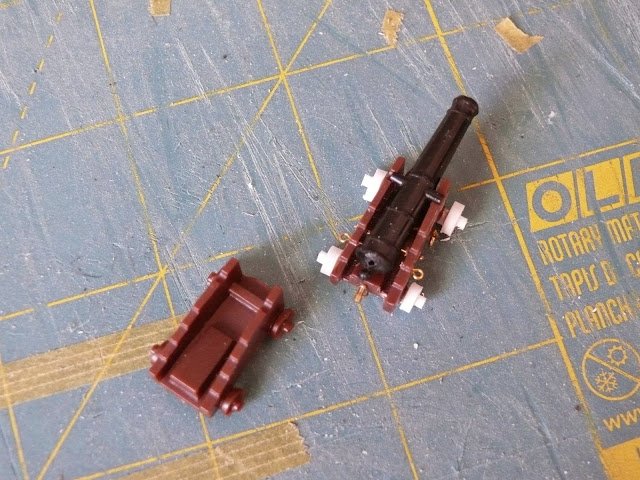 This is my first pass and I may need to make further refinements before settling on the final version. I will probably only "trick out" 10 or 12 of these and do some simpler modifications for the rest that won't be seen once the spar deck is in place.I hope to post more progress soon.Thanks for your continued interest!Evan
This is my first pass and I may need to make further refinements before settling on the final version. I will probably only "trick out" 10 or 12 of these and do some simpler modifications for the rest that won't be seen once the spar deck is in place.I hope to post more progress soon.Thanks for your continued interest!Evan -
Folks - thanks for all the LIKES!
Brian - Thanks for looking in. I think (as you probably suspect) that the netting over the gun port openings is a safety measure and not authentic. It may be, however, that netting was placed over openings like transom/stern gun ports that didn't generally have a gun in position...
Tim - I think the Ropes paintings of the Java battle are on loan from a museum or historical society in New Bedford. They are jewels of detail...
Stuart - thank you also for looking in... Glad to see you starting your own build! Tyrone Martin in his "Creating a Legend" book indicates that the interlocking planks were added on the gun deck in two "thick strakes" running the length of the deck. The modern restored ship shows similar interlocking planks on the outer edge near the waterway on the spar deck:
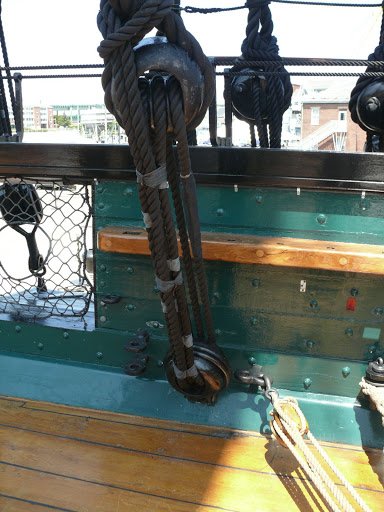
I'm not sure that is authentic to the 1812 period.
You can sorta see my feeble attempt to replicate the interlocking gun deck strakes in this view:
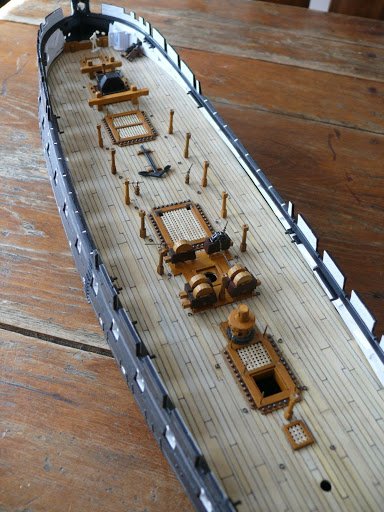
The yellow gun stripe is controversial among purists... The Constitution's log clearly shows the stripe being painted white (and the bulwarks green) immediately before the outbreak of war. The Hull model in Salem also shows a white stripe. Accounts and log entries do verify that Captain Stewart changed the stripe to yellow on his late war cruise. I've used the Corne paintings for guidance in the belief that some captains (including Stewart and Bainbridge) likely changed the color for deception once the shooting started. Regardless of counter opinions, I'm falling back on the Corne paintings and I'm sticking to it!
Thanks again for the interest and I'm looking forward to following these new builds!
Evan
-
-
Folks
I've been neglecting my build for many weeks... Late summer travel and life adventures.
I did manage to make my way to the Charlestown Navy Yard for an Old Ironsides fix. As many of you know, she'll enter the yard in early 2015 for an extensive three year restoration so this was a last chance to walk the decks for awhile.
I got some more photos of the correct carronade:
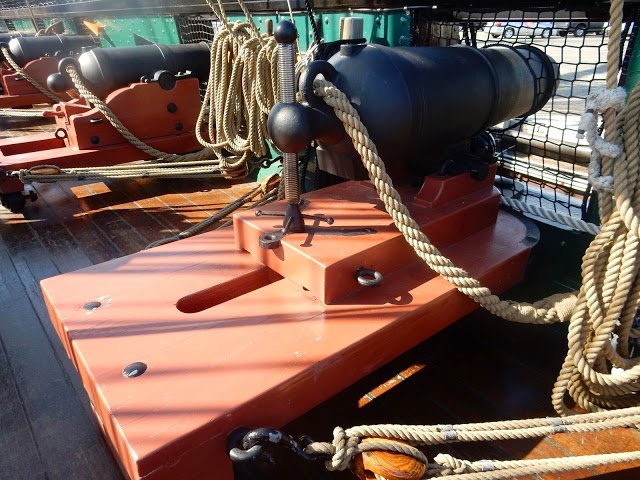
Also a good shot of the interlocking planking on the gun deck:
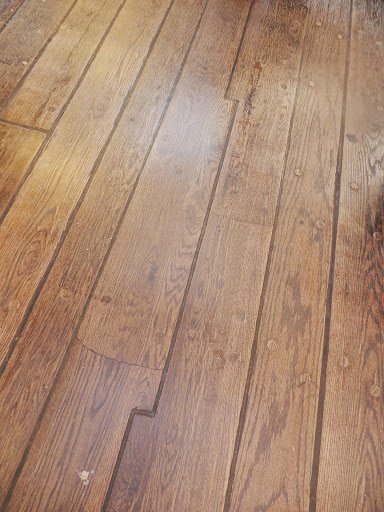
The kids are at an age where they can appreciate the interactive displays inside the Constitution museum. They were put to good work:
Hoisting livestock onboard:

Holystoning the deck:
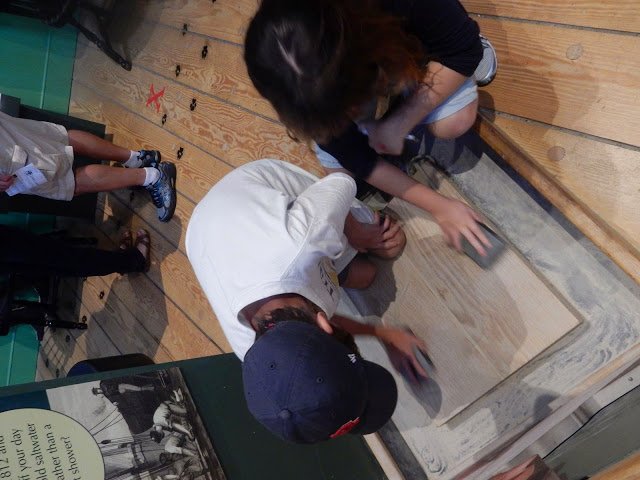
And shortening sail:
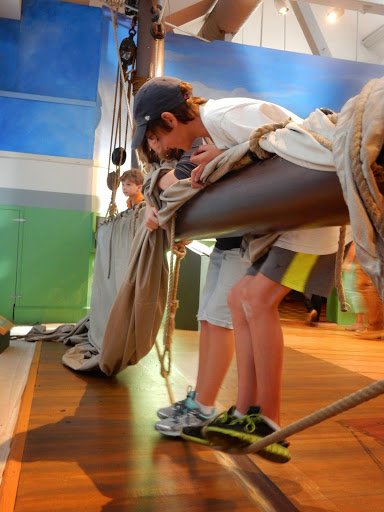
They will make good topmen one day!
The bell that Constitution carried into the Guerriere battle was cast by Paul Revere and sadly destroyed. Here is the one requisitioned from the Guerriere:
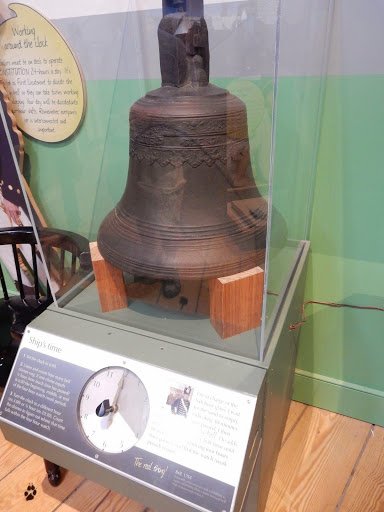
And here is a shot of my favorite artifact in the museum - a hand drawn diagram by one of her lieutenants of the battle with Java. You have to find a little box on the wall and open the door:
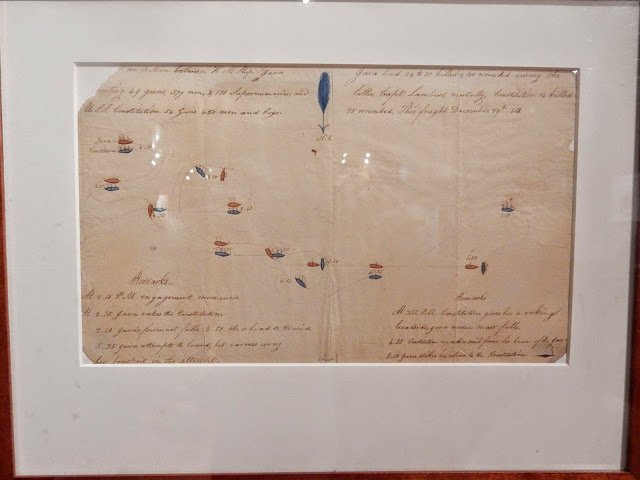
Many folks don't realize that Java stern raked Constitution TWICE during the battle.
Here are some interesting detail shots from a series of paintings of the Java battle done by George Ropes Jr. - the deaf/mute apprentice of Michel Felice Corne. I hadn't seen these paintings before:
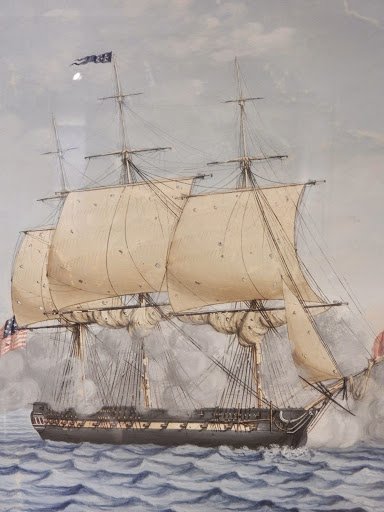
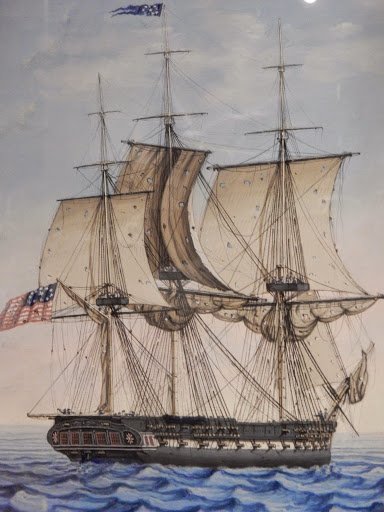
These also suggest a pale yellow stripe and five stern windows for those who care to ponder such things.
Altogether it was a great day in the Navy yard. The only disappointment was not being able to make Henry's acquaintance. I flubbed up the coordination with our rendezvous. The kids and I got caught up in the long queue inside the Bunker Hill monument... By the time we got down and over to the Navy yard the 1812 Marine detachment had decamped for the day and Henry wasn't able to hang back.
We've had brutal heat and humidity for much of the past few weeks here and it has only just now abated enough for me to venture back into the garage workshop. Fiddling with the 24-pdrs...
Thanks again to those who follow my build log.
Evan
- GuntherMT, JerseyCity Frankie, dafi and 4 others
-
 7
7
-
I'll chime in here... Firstly, we should properly denote this rig as the "Rudder Pendant" tackle to stage any discussion.
Let's not assume this gear is only for emergency steering. The 1828 Webster's dictionary includes a definition: "The rudder-pendant is a rope made fast to the rudder by a chain, to prevent the loss of the rudder when unshipped." There are many documented instances of the rudder being unshipped by a storm or grounding... Oftentimes it was the pintles and gudgeons that were broken or wrenched loose causing the rudder to break away. Admiral d'Estaing's flagship lost her rudder in a violent gale off the Chesapeake during the American Revolution.
It is most likely that the rudder pendant served ALL of the aforementioned purposes. Lawrence Mott in his "The Development of the Rudder: A Technological Tale" notes that this tackle "Prevented the rudder from swinging too far to one side, helped control the rudder in rough weather, and acted as emergency steering in case the tiller broke."
I would think that the need to use the pendant tackle for emergency steering was the least common purpose... Certainly ships like the Victory and Constitution had the ability to insert a replacement tiller on the rudder head and/or jury rig new steering tackle inside the ship in cases where the main steering tackle was damaged. Resorting to exterior rudder pendant tackle would be extreme - likely only done when the rudder head itself was damaged and the rest of the rudder was still intact. Having this tackle in place to prevent the loss of an unshipped rudder was probably much more useful to seafarers back in the day... Much better to be able to retrieve and repair the existing rudder than to make one from scratch when away from a dockyard. The flimsy replacement made for the St. George ultimately failed in the midst of the next storm.
The lower portion of the tackle (below the counter) is the "rudder chain", the remainder is the "pendant" of rope that is typically led up to the mizzen chains and tied off around a deadeye or an eyebolt on the channel. I think the restored Victory has it led up through a hole in the channel and secured with a stopper knot (at least when I last visited her in '97). When rigging the rudder chain to the spectacle plate on any model, attention should be paid to the arc of the rudder to make sure it can swing - but not too far.
In the rare case where the pendant tackle was used to control the rudder, it is my understanding that the crew commonly set up a spare spar as an outrigger and passed the pendant line through a block on the end and back through an open port so that the pendant didn't rub against the side of the ship and the mechanical leverage was maximized.
Evan
-
Thank you Shroeter for the very kind note.
I hope I'm diligent enough as I go along to relay meaningful detail about my processes and decisions to help inform the next modeler. I suspect the next wave will improve on my methods and build on what I have done to get the most out of the venerable 1/96 Revell kit.
Please don't hesitate to chime in often and ping me with any questions or requests for clarification as you follow along... Hope to see some postings of your effort!
Evan
-
Michael - indeed, I hand painted each using Vallejo air copper, roof brown, hammered copper, and grimy black all randomly blended together in different combinations and applied with disposable micro brushes. Twenty minute sessions staggered across a week or so when I could grab an odd moment to slink out to the workbench.
Evan
-
I recently struggled with how to represent the copper sheathing on my own build - the classic 1/96 Revell kit of the Constitution.
Many of us of a certain age (say something north of 50) can remember when American pennies had a much higher copper content. Every family had a jar full of pennies that showed a wide variation in color and tone. Most were shades of brown, some were black, some had green... a few were shiny. I thought it would be worth the effort to add this same kind of variation to the underside of my Connie and make many of the detailed plates "pop" for a better visual effect.
In addition to the variation found in the old jar of pennies, I was influenced by some cursory research into the production of copper sheets by Paul Revere. Thank goodness for Google and Wikipedia...
Most of you already know that Revere provided the first copper sheets made in America and used on the Constitution. He recognized an opportunity to launch a new industry and invested in an old ironworks in Canton that could utilize the adjacent river for the necessary power to turn the gears of the rollers and power the industrial hammers needed to crush ore. Revere had sent his son to England to glean what information he could on methods for rolling copper. This info combined with his own experience in working with forging of copper and Iron (and of course silversmithing) gave him enough confidence to proceed. Benjamin Stoddert, the Secretary of the Navy at the time, was encouraging domestic sources for vital military materials such as copper sheathing and offered to help fund Revere's initial effort. The US Government provided a $10k loan and the first batch of raw copper for processing into sheets - an early example of federal subsidy of the military industrial complex. There were no reliable domestic sources for large quantities of copper, so England and other overseas sources were needed. Additionally, Revere was smelting and refining domestic copper in small amounts from Pennsylvania mines in the hopes of establishing some independence from these foreign sources. Metallurgy in that day was clearly a far cry from what we have today and the consistency and quality would vary widely which would naturally introduce color variation.
Secretary Stoddert preferred that Revere use a "cold rolling" method for flattening the copper through a series of heavy iron rollers into thinner sheets. He felt that this would harden the material for greater strength. Paul Revere, however, successfully argued for a "Hot Rolling" method which would anneal the copper as it was flattened through the iron rollers with a final cold rolling pass to add some strength. This approach, however, introduces "mill scale", which is heavy oxidation on the surface caused by the recrystallization of the metal under heat. The final cold rolling would help to reduce the scale problem and give the sheets a better finish. The heating of the metal would further introduce color variation in each batch - especially when a consistent temperature is not applied. Revere used plentiful New England hardwoods to heat his "furnace" instead of coal as used in England. This likely introduced more color variation than the copper sheathing imported from England.
Finally, it appears to have been common practice for the shipyards to store the copper sheets in open sheds to allow some natural oxidation that would help flake off any remaining mill scale. This period of "weathering" would also introduce wide color variation as different batches were stored for different periods before use - like the old pennies in the jar.
I think it highly unlikely that any ship of the early 19th century was ever sheathed in shiny copper of consistent color. Even when first applied to a new ship on the ways, you'd have seen a patchwork of color and tone in the underside copper plates. That is essentially what I've tried to depict.
All of this brain dump aside, I readily acknowledge that all of the choices made by modeler's for representing the copper plating is good by me... A nice even coat of copper paint on the hull produces a beautiful effect. The use of copper tape seen in some of the newer builds is also a great approach - absolutely gorgeous stuff. I just prefer the patchwork effect - purely artistic license.
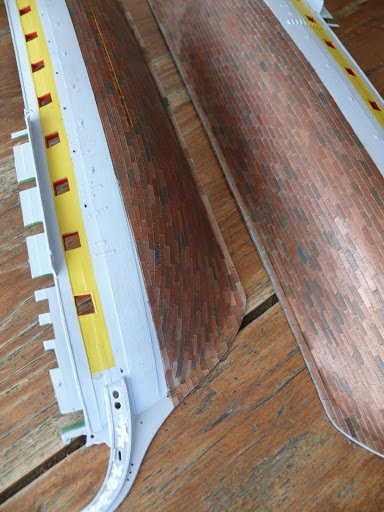
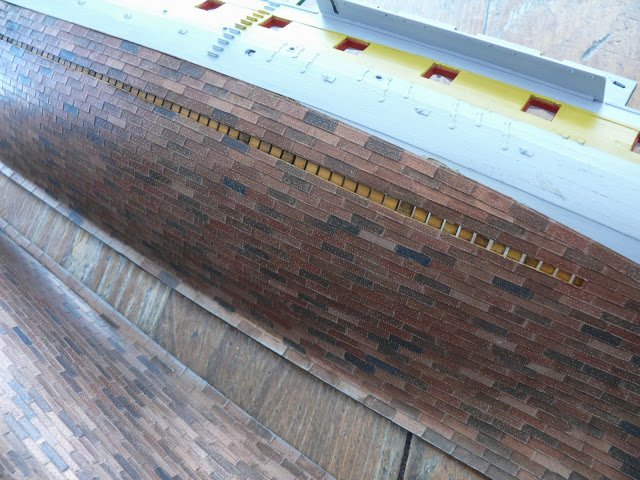
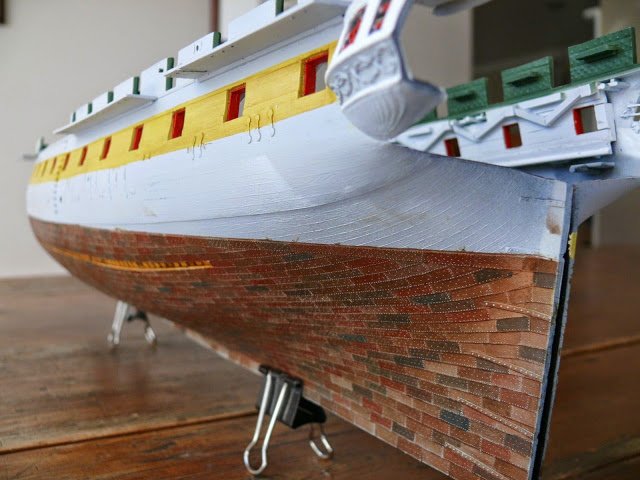
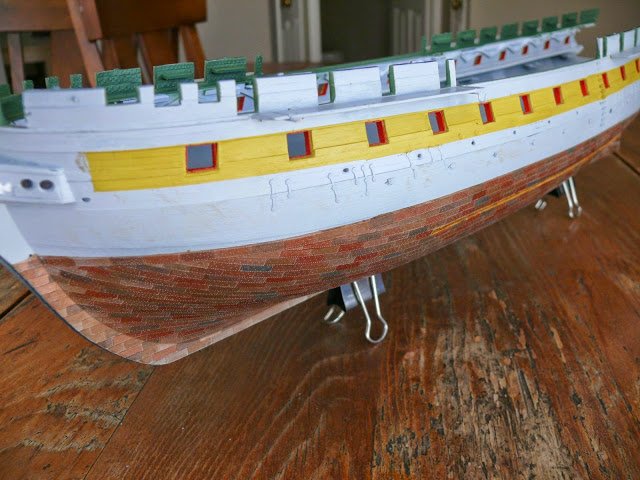
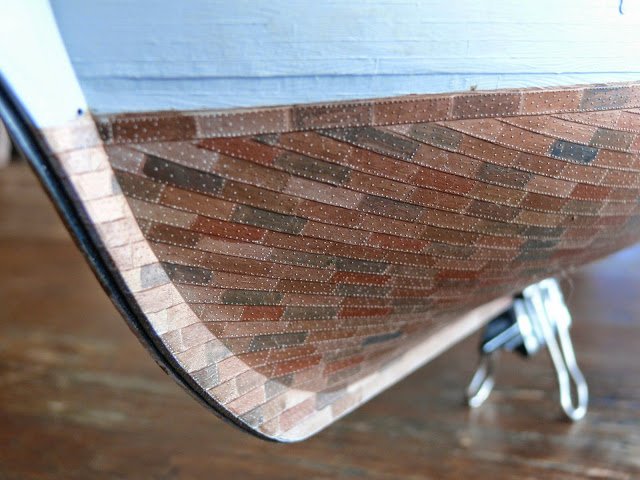
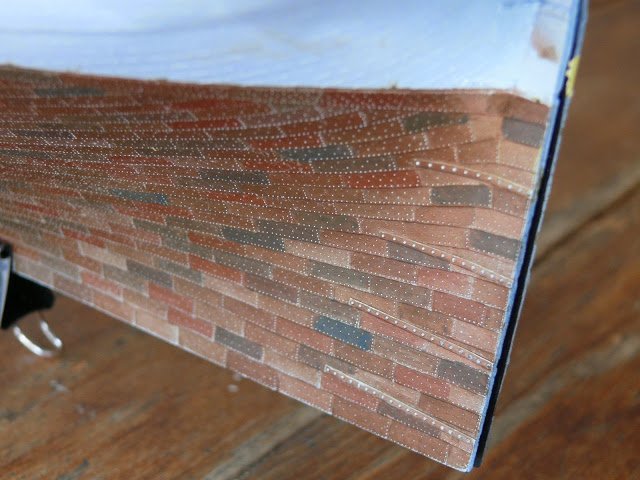 BTW - Here is a link to a nice overview of the Minerva model in the USNA Rogers collection:Good discussion.Evan
BTW - Here is a link to a nice overview of the Minerva model in the USNA Rogers collection:Good discussion.Evan -
Chris
Great start to a great project. I have not yet proceeded to the guns on my build...It looks like you've created quite an assembly line.
Evan
-
More commonly referred to as a "Kedge Anchor" back in the day. Smaller vessels might use these for more common anchoring tasks... larger vessels would use these for light duty - usually to warp the ship around in harbors or shallow anchorages. Also used to pull a ship thru narrow passages or rivers.



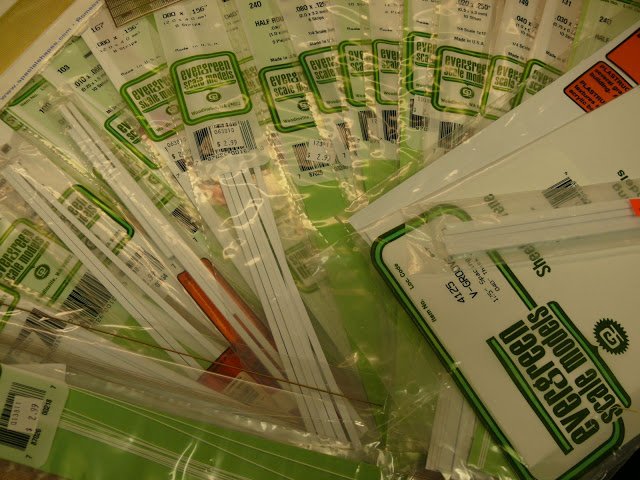
Pre-Printed Deck Planking - moved by moderator
in Building, Framing, Planking and plating a ships hull and deck
Posted
You could also try John at scaledecks.com